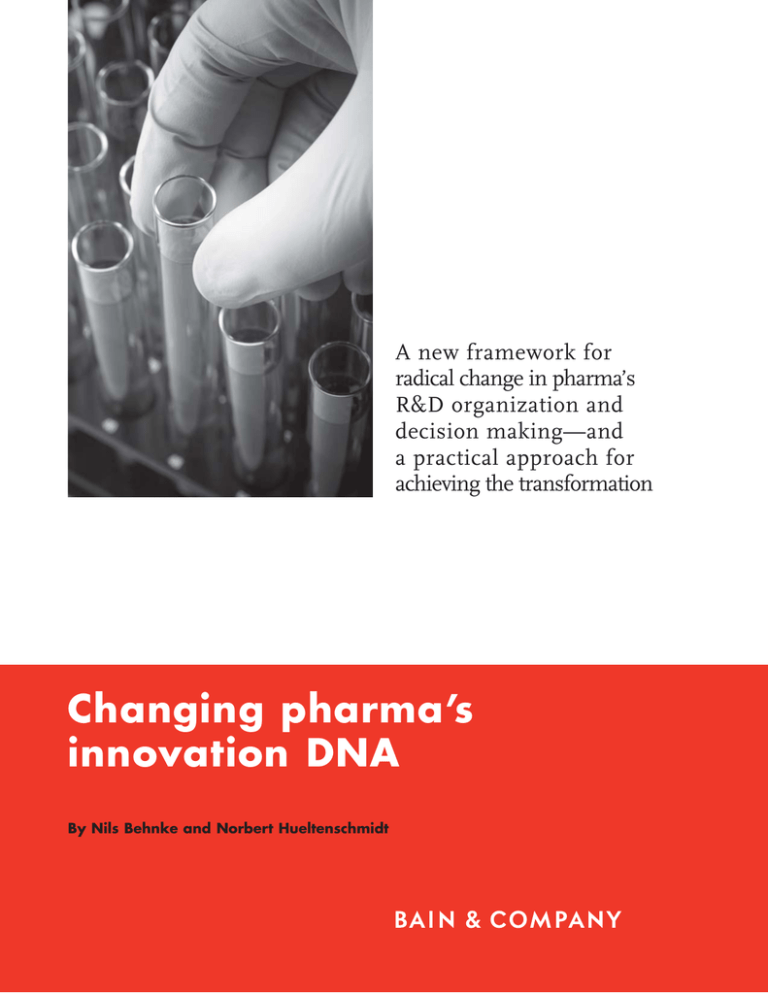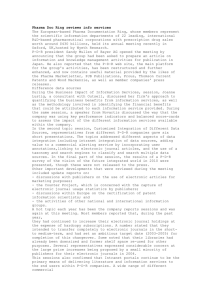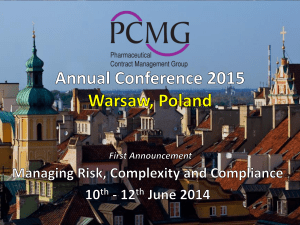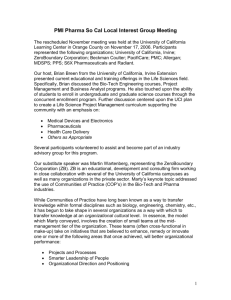
A new framework for
radical change in pharma’s
R&D organization and
decision making—and
a practical approach for
achieving the transformation
Changing pharma’s
innovation DNA
By Nils Behnke and Norbert Hueltenschmidt
Nils Behnke is a partner with Bain & Company in San Francisco in the Global
Healthcare practice. Norbert Hueltenschmidt is a partner in Bain’s Zurich office
and leads the Global Healthcare practice.
Copyright © 2010 Bain & Company, Inc. All rights reserved.
Content: Manjari Raman, Elaine Cummings
Layout: Global Design
Bringing innovation to life: Changing pharma’s discovery DNA
A new framework
for radical change in
pharma’s R&D organization and decision
making—and a practical
approach for achieving
the transformation
It’s no secret that Big Pharma’s traditional
research and development (R&D) engine needs
a complete overhaul. What’s surprising is how
long the industry’s taking to fix the problem.
Despite a number of bold efforts to bring
pharma R&D back to higher productivity levels,
the pace of innovation remains anemic: the
long-term average lags at one new molecular
entity (NME) a year per company. Despite R&D
spending at a high 18 percent of revenues,
Big Pharma’s R&D productivity declined by
20 percent between 2001 and 2007¹. The cost
of bringing a new drug to market currently
runs at more than $2 billion, clearly an unsustainable level. Mergers and acquisitions and the
creation of mega-companies have not compensated for the slowdown in innovation. As a
result, analysts lowered expectations and now
hope the global pharma industry will at least
eke out a compounded annual growth rate of
1 percent in revenues over the next five years.
Faced with patent expirations, rising expenses,
competition from generics and pressure on
branded drug prices, Big Pharma’s revenue
gap could balloon to almost $100 billion by
2014. For the top 20 biopharma companies
in the world, this represents an annual earnings decline of 8 percent. Most companies
find that even shopping for innovation externally cannot help close the gap. Recent Bain
analysis of 6,000 biotech projects, available
for late-stage licensing, shows that only about
200 are likely candidates for a large pharma
company. Of these, fewer than 100 show poten-
tial to become top-sellers and taken together,
they account for only about $30 billion in
potential revenue.
Pharma companies are striving hard to stave
off the R&D crisis through mergers and acquisitions, geographic expansion, and diversification into new areas like consumer health.
But they recognize that while these efforts
yield more predictable sales in the future, they
have limited impact on the profit gap. The US,
Japan and Western Europe still account for
80 percent of the global market and recent
growth in emerging markets cannot replace
lost revenues or profits. Diversification into
other healthcare businesses does not help fill
the profit gap either, as over-the-counter medications have much lower margins compared
with prescription drugs.
With the innovation burden hanging heavy
over the industry, many companies have
started to experiment with new R&D models.
GlaxoSmithKline (GSK) restructured its R&D
centers to emulate biotech R&D principles.
Still a work-in-progress, GSK hopes to replicate
an entrepreneurial culture in a large pharma
organization. Eli Lilly acquired ImClone to
source innovation from outside the company
and then left it as a stand-alone unit operating
independently. Pfizer and GSK broke down
corporate barriers to share intellectual property
and assets to develop new drugs for diseases
like HIV. Several pharma companies are partnering with leading academic institutions to
promote innovation from basic research.
However, the jury is still out on whether these
efforts prime the innovation pump enough.
Instead, our analysis as well as a survey by
Bain & Company of 20 leading global innovators—responsible for some of the greatest
breakthrough medicines in the last few decades—
suggests that Big Pharma needs to do even
more. The efforts made so far point the industry
in the right direction; now companies must
press ahead to go much further. They need to
1
Bringing innovation to life: Changing pharma’s discovery DNA
break through the barriers that currently hold
them back. To raise innovation returns back
to the level in the era of blockbusters, pharma
companies need transformational change: change
that renews R&D but also cuts across the entire
company. Such radical change goes to the root
of the problem and explores what holds back
innovation—and identifies what can be done
to create a vibrant new culture of innovation
across the organization. It requires hard decisions to give up entrenched legacy behavior,
but also it requires an openness to bring back
what worked in the past.
By nature, such change is difficult and takes
time to implement. Inevitably, it pre-supposes
strong leaders who persevere. In the following
pages, we share the findings of our research,
develop a new framework for radical change
in pharma’s R&D organization and decision
making—and offer an approach on how to
achieve the transformation.
The innovators’ perspective
To understand what ails pharma we spoke to
innovation leaders with a proven track record
of creating breakthrough medicines. They
brought to the discussions a deep knowledge
of academia, venture capital and the current
state of biopharma discovery and development
capabilities. We conducted in-depth interviews
to probe for what they considered key success
factors for innovation. We then asked them to
rate each factor on its importance. Finally, we
asked them to identify the strengths and weaknesses of biopharma companies compared with
these factors (see Figure 1).
First, the good news: These innovators strongly
believe in the potential for future innovation.
They see no set limit to how many new products
biopharma companies can develop per year.
Nor do they believe the industry has run out
of technological advances required to develop
new products. They identify two critical areas
Figure 1: Feedback from innovators: Pharma’s current strengths lie in areas that matter less,
comparatively, for innovation
Most
important
Incentives aligned with research goals
Ability to attract talent
Managerial autonomy
Leadership to enable diversity of
skills and capabilities within the scientific team
Access breadth
of disciplines
Minimal bureaucracy
Importance
to innovators
Flexible organization
Ensure communication
between disciplines
Prioritize based
on commercial
and scientific
potential
Least
important
Low
Set clear
goals and
priorities for
research
High
Pharma’s capabilities
2
Funding
resources
Bringing innovation to life: Changing pharma’s discovery DNA
for the success of new product development,
in which pharma excels: raising funds and
providing access to technologies. They also
credit Big Pharma with superior skills in strategy
and pipeline management—but herein lies
the rub: They rank these two skills as least
important for success in innovation.
incentives got aligned with annual throughput. Subtly, that shifted the pressure on
numerical outcomes: Getting the project
to the next phase became as important as
getting it right.
•
As they grew more complex, pharma companies became risk-averse. As the stakes
rose, at every gate, research projects got
more input and feedback from various
functions across the pharma company: The
marketing department weighed in, the
strategy team pitched in with a portfoliomanagement lens, and cross-functional
committees became routine. Over time,
this created a bias to minimize risk. Truly
game-changing projects, with a perceived
lower probability of success, struggled to
survive the funnel. The more the system
rewarded the same way of doing things,
the more the odds stacked against rulebreakers. In a world of scientific breakthroughs, however, pharma companies
needed more discontinuities and disruptive
ideas for successful innovation.
•
Many pharma companies grew too big to be
effectively managed as one organizational
unit for innovation. Today, pharma pursues
scale on several dimensions: a global footprint, a diversified product portfolio, influencing new stakeholders and dealing with
stricter regulatory requirements. Most of
this requires building additional internal
capabilities—and a large part of pharma’s
rising expenses now go to supporting
scale, rather than innovation.
According to the innovators, the other pressing
areas of improvement for pharma companies,
in order of importance, are: increasing managerial autonomy; aligning research goals with
incentives; attracting and retaining the right,
creative talent; minimizing bureaucracy; and
creating flexible organizations. In addition, when
pressed to identify why in recent times pharma
companies struggled to innovate successfully,
the innovators identified some common themes.
•
•
Scale crept into every aspect of the business.
In the 1980s, when Big Pharma produced
blockbusters with much greater frequency,
internal champions often led innovation.
These leaders could rally the troops across
functions and shift the focus of R&D efforts
nimbly. Then began the industry’s quest
for repeatability and efficiency—an industrial manufacturing approach focused
on “throughput” and “risk mitigation.”
Repeatable processes delivered a host of
benefits for Big Pharma. For example, the
industry found a steady source of revenue
in marginally-differentiating products and
making them “evergreen” through extended
releases or co-formulations. But innovation
suffered when eventually, pharma companies
tried to industrialize even the non-scalable,
truly creative steps in product generation.
The vision of success in drug discovery
and development got diffused by averages
and probabilities. Investment decisions in
pharma companies shifted to a “numbers
game.” As ideas for drug innovation funneled through several stages, pharma
companies measured success in terms of
progression from one gate to the next. At
the level of the organization, increasingly,
For most innovators, a “broken
innovation culture” lies at the
core of pharma’s
problems.
For most innovators, a “broken innovation
culture” lies at the core of pharma’s problems.
The rest they cited as symptoms: the lack of
dedication to deeply understand the disease
biology; the inability to engage in “true” partnerships with academia and biotech; the substantial turnover at the R&D executive level;
and a lack of passion to explore new ways to
undertake R&D. A majority of the innovators
believe that to stoke innovation, biopharma
3
Bringing innovation to life: Changing pharma’s discovery DNA
must rethink how to reward the right behaviors
and create the required flexibility within the
organization structure. Says a biopharma head
of research, with two successful biotech ventures to his credit: “It all goes back to incentives. If you do that well, you wipe away the
red tape.” Another successful biotech entrepreneur adds: “Leaders in R&D should have
the autonomy to make decisions on how to use
funds and allocate resources between programs.
They should be able to hire the right number
of right people, and not have to staff research
projects with whoever is available.”
in select areas of discovery, development and
life-cycle management. In other areas it partnered with contract research organizations.
Today, the combined company’s fixed assets
account for less than 50 percent of its total
resource needs—which, compared with competitors, leaves much more available for research.
Of course, no one innovation model will fit all
pharma companies. However, we believe in
the future, successful pharma innovators will
share three common fundamental principles.
1. They will pursue medical differentiation
New approach to innovation
It goes without saying—but it also bears repeating—that only leaders can bring about transformational change. Over the next few years,
Big Pharma leadership will face two tests: First,
reigniting innovation such that it leads to the
creation of new, discontinuous technologies.
Second, morphing the current organization
structures into new forms that nurture discovery
and development—and result in new business
models. Speed will be important as most leaders
will not have the luxury of coming into an
organization and learning how things are done.
Successful leaders will need to recognize the
right moment and grasp it to launch such
radical change. In the case of one mid-sized
European pharma company for example, the
timing coincided with its acquisition of another
European pharma company.
The acquiring company used the integration
process as a proxy to fully redesign its R&D
approach. It set itself a new goal: to achieve an
optimal balance between portfolio assets and
fixed operating costs. Its new R&D approach
was not just highly selective—the company now
only pursues opportunities with real medical
differentiation—it was also purely priority-driven,
so that only valuable projects got resources.
To achieve these goals, the acquiring pharma
company took nothing for granted while creating a lean, scalable and flexible organization.
It retained in-house critical core capabilities
4
As a generic standard-of-care settles in for
many diseases, pharma companies will need
a higher degree of medical differentiation to
successfully introduce new products into the
market. This isn't a new idea. In the 1990s,
the pipeline for cancer treatments got crowded
with pharma companies developing new
chemotherapies, most with little therapeutic
difference. However, instead of becoming a
“me too,” Genentech concentrated on changing
the way cancer is treated. With the help of
PDL’s humanization technology, it developed
treatments based on humanized monoclonal
antibodies—a technology that most pharma
companies considered too complicated. The
company’s researchers focused on understanding tumor biology and set goals to take patient
outcomes to a new level. Genentech’s reward:
Its innovative approach helped it gain market
leadership. In addition, Genentech was able
to price its therapies several times higher than
pharma’s marginally improved options.
In today’s market, differentiation is more
important than ever. Now, increasingly, Big
Pharma’s customers are payers (very often
government customers) and patients who care
about two criteria: health outcomes and affordability. Further, it’s a much more transparent
marketplace. Government agencies develop
cost-effectiveness studies; private payers invest
in health technology assessments and analyzing real-life medical data; and most information
Bringing innovation to life: Changing pharma’s discovery DNA
is available on the Internet. This new reality
has a number of implications for innovation
in biopharma companies. First, servicing the
new customer requires an innovation engine
that produces cost-effective, tangible improvements in healthcare. That, in turn, requires a
whole new decision-making process, especially
in the early stages of R&D. For example, to
ensure that a drug is priced right at the time
of its launch, a pharma company might explicitly include early-stage hurdles to test for
cost-effectiveness.
Second, pharma companies will need to review
portfolios to identify opportunities where they
are better off collaborating versus investing
in differentiation. Already, the market is less
willing to pay pharma companies to develop
similar, marginally different products that
require a huge amount of competitive marketing spending for promotion. Some pharma
companies have taken steps to pool resources—
more such collaborative models will evolve in
the future. And third, pharma companies will
need new criteria and processes for evaluating
their pipeline. As companies consciously shift
a significant portion of their R&D budget to
potential game-changers, by definition, they
will take on more risk. To buffer against risk,
companies will need to adapt their current
approach of treating all projects in the pipeline
as equals. Instead, they will move closer to the
way investors manage a portfolio: balancing
low-risk, low-return assets with high-risk,
high-return assets.
2. They will invest in building
flexible organizations
Leading pharma companies will be the first to
admit that often, decisions suffer death by
committee. The malaise is not uncommon:
As organizations grow and expand, they adopt
more complex structures and processes. Over
time, complexity becomes a drag on the quality
and speed of decision making. Ineffective
decision making can stifle innovation. Pharma
companies need to test early and consistently
for what really matters in a drug-development
project. For this, they need to have incentives
in place to get to the right answer and set the
right research goals. While killing a project
early—especially for mediocrity—is hard for
most organizations, in pharma it’s critical for
continuous, successful innovation.
In our survey, industry experts stressed that
Big Pharma must develop incentives that reward
rapid learning, testing and adaptation from
pilot projects. But that requires delegation in
decision making, which is hard to do if a pharma
company is dependent on centralized processes.
To get around the issue, a pharma company
can view all projects through an investment
lens: allocate resources based on pre-determined
proof-points; delegate authority down the line
to people running the innovation processes;
and increase autonomy in areas like outsourcing
or staffing decisions.
A good first
step will be to
dismantle the
pharma company’s functional
staffing model
and replace it
with a more
flexible human
resource model.
To make the approach work, a good first step
will be to dismantle the pharma company’s
functional staffing model and replace it with
a more flexible human resource model. Under
such a structure, empowered project champions
can freely use their budget to find the right
skills and resources, which might come from
within the organization or outside. Some companies like UK’s Vernalis or Big Pharma-backed
initiatives like Chorus have established virtual
development as a viable and often more effective and efficient development model.
Such companies don’t just manage costs better
by limiting full-time employees, reducing fixed
assets and clamping down on overheads; their
flexibility and lean structure helps them hone
in on successful innovation or quickly move
on to the next promising idea. Chorus, which
was set up by Eli Lilly as an autonomous division, advanced more than two dozen molecules
through candidate identification and Phase I,
at median cycle times that were 40 percent to
60 percent faster than the industry average.
According to one innovator we surveyed, outsourcing became a learning tool for the organ5
Bringing innovation to life: Changing pharma’s discovery DNA
ization. Says he: “Large, readily available internal resource pools dull the mind and drive the
decision to action rather than thought. With
outsourcing, the process is reversed.”
To unleash innovation, Big Pharma will need
to revisit its singular approach to R&D and
differentiate between activities: One, activities
that warrant process innovation and two, those
that should not be over-engineered but allowed
autonomy in order to fuel creativity. Some
pharma companies such as Roche have already
begun this process by separating research and
early-stage development from later-stage development into two organizations.
3. They will balance the use of scale
While scale can be an enormous commercial
advantage, it can be kryptonite for innovation.
That raises a challenge for pharma: Where does
a company draw the line? Clearly, scale has a
place in pharma development in late stages of
development, particularly for very large-scale
trials, as well as manufacturing. In fact, any
process innovation that is repeatable can be
industrialized, not just in later-stage development, but even in early research or areas like
medicinal chemistry. Where scale often doesn’t
work is in areas of true product innovation,
where ingenuity matters. In such instances,
pharma companies need milestone-based
processes where progress in projects can be
reviewed on an individual basis.
An emerging new R&D model
Seeking medical differentiation, building flexibility in an organization and revisiting processes
to identify the ones best suited for scale versus
creativity—each goal is challenging by itself.
Taken together, they can radically transform a
pharma organization. In practical terms, what
would this degree of change entail? While each
company will want to find its own unique
solution, consider one hypothetical model for
a large, innovation-led pharma company (see
Figure 2).
Figure 2: New innovation model: Innovation Centers (ICs) with an external focus and a
high degree of scientific and entrepreneurial freedom
HQ –
innovation
Investment board,
payer and provider panels
Internal
innovation
Shared service technology platforms
IC
Scientific
advisory boards
Oncology
IC
IC
MS
Alzheimer’s
Prioritized franchises for diseases
Low priority programs to
divest/outlicense/spinoff
External
innovation
Oncology projects
MS projects
Alzheimer’s projects
About 80–90% of innovation is externally sourced
6
Business
development
Bringing innovation to life: Changing pharma’s discovery DNA
At the core of this company’s new innovation
model are Innovation Centers (ICs) focused on
specific therapeutic or disease areas. Depending
on the stage of the innovation and the nature
of their work, these ICs are based on different
criteria such as more internal or external
resources; unique milestone or success definitions. The ICs share only a few internal service
technology platforms—those that are truly
proprietary, like RNA interference—but they
have some common characteristics:
•
The ability to attract and retain the best talent,
especially scientists and innovation managers
(two very distinct roles that are often conjoined in today’s pharma organizations);
•
The expertise to identify and access the best
science within their disease area, be it
internal or external;
•
The ability to conduct limited internal
research for validation;
•
The allocation of the IC budget among
programs, such that there is an adequate
balance between the internal and external
sources of innovation; and
•
The ability to flexibly hire the right staff
for specific projects, and maintain very
limited permanent staff, mostly functional
management. In particular, this fluid
organization structure should encourage
the creation of more “dual staffing” roles,
where academic researchers are invited
to work full- or part-time on commercial
pharma projects.
•
The flexibility to create ICs at a regional
or global level, based on ensuring that
they attract the best talent, with the right
cultural fit.
To make the model work, the pharma company
puts in place the right incentives for each IC team.
While incentives vary substantially from IC to
IC, they are always multi-year, aligned with the
specific business plan and linked to milestones.
Just as in biotech, key contributors get significantly rewarded for real success; but instead
of being tied arbitrarily to the annual stage/gate
processes, their success is measured in NDAs/
BLAs² or any other dollar-related exit criteria
the company chooses.
ICs are tested on their progress against business
plans regularly in a peer review with external scientific advisory boards. The process goes beyond
checking off metrics to a more qualitative
assessment that asks questions like, “Is the
scientific progress strong enough to meet unmet
medical needs and is it sufficiently differentiated from alternatives?”
The pharma company’s business development
team works closely with ICs to enable access to
external science. The skill set required for business development requires substantial flexibility
in contracting and deal-structuring abilities.
Once again, this is about making things happen
rather than checking lists for in-licensing criteria. The team drills down on how to maximize
the value of assets, identifies low-priority programs to be shed in disease areas that are no
longer a priority, and actively nurtures its
networks in academia and biotech.
The role of the R&D chief is no longer to coordinate processes in a prescriptive manner for earlystage R&D, but to be a strategic architect and
portfolio investor. In concrete terms, the R&D
team becomes the organization’s headquarters
for innovation. It sets the R&D vision and
provides strategic direction (which TA/DAs³,
underlying biologic mechanisms and new
technologies should the pharma company invest
in?), objectives (what are the right multi-year
goals for the company?) and budget allocation
(how do we allocate resources among the various ICs?). While these decisions need to support the overall R&D business case, this is no
longer a one-size-fits-all approach with annual
throughput (how many programs did you
advance into the clinic?), but rather a process
similar to venture capital investment in biotechs
(in the next round, what are the proof-points
we need to continue investing?).
7
Bringing innovation to life: Changing pharma’s discovery DNA
Those innovation investment decisions are challenged regularly by an investment board that
includes internal executives (except those, such as
the heads of the ICs, who might have a conflict of
interest) as well as outside members. This board
provides more than scientific advice—and
therefore, includes “customers” such as payers
and healthcare providers. They review IC business plans with an eye on return on capital
invested and set specific metrics and milestones.
The model pre-supposes the separation of late-stage
development (III and IV) into one development
organization that spans all therapeutic areas and
geographies: a veritable global “innovation marketplace.” This organization takes into account
the perspectives of the customer and the market
and excels in providing the necessary regulatory proof for the molecules developed by the
ICs as quickly and cost-efficiently as possible.
The challenge ahead
We believe Big Pharma can build just such an
innovation-led organization—if its leaders
have the appetite and patience to embrace
change. Like all metamorphosis, transforming
a large pharma company will be a slow, sometimes uncomfortable process. Leaders will
need to probe deep before embarking on the
mission. What are the concrete unmet medical
needs the company can target? Which improvements in patient health will justify an attractive
price point that governments, payers and patients
are willing to pay for? How does the company’s
proposed solution compare with what is currently available in-house, what the competition
is doing and what the R&D team believes is
technically feasible in the near future?
The burden will fall on Big Pharma leaders to
personally set a new course—even as one hand
steadies the helm. In order to be successful,
leaders will have to rise above the competition
and establish new rules of innovation-led
productivity and then get down to the nittygritty of transforming the organization. It’s a
tall order for most organizations, but not
8
unprecedented. Apple reinvented itself by
making a conscious decision to focus on discontinuous products, like the iPod, iPhone and
iPad, versus investing in yet another update
of the Apple operating system. The company
repeatedly outsmarted the industry by successfully challenging the status quo and questioning “how things are done.”
Pharma also requires that level of decisive
leadership in order to launch a new era of innovation. For once, the timing couldn’t be better.
Externally, investors realize pharma innovation
needs to be fixed. Currently, they attach little
value to discovery and early-stage development
in their valuation—and therefore, even in the
worst case, the potential negative impact of a
new innovation strategy on price-to-earnings
ratios is likely to be low. Internally, as in all
organizations on the cusp of transformation,
employees already know what’s not working.
They await bold leadership and an inspiring,
energizing mission—or at least, for a start, a
promise of change. As one executive vice president of R&D says: “The only thing I know for
sure is that we can’t keep doing the same thing—
and expect a better outcome.”
1 New molecular entities/biologic license application per dollar of
R&D spending
2 New drug application/biologic license application
3 Therapeutic area/disease area
Bringing innovation to life: Changing pharma’s discovery DNA
Bain’s business is helping make companies more valuable.
Founded in 1973 on the principle that consultants must measure their success in terms
of their clients’ financial results, Bain works with top management teams to beat competitors
and generate substantial, lasting financial impact. Our clients have historically outperformed
the stock market by 4:1.
Who we work with
Our clients are typically bold, ambitious business leaders. They have the talent, the will
and the open-mindedness required to succeed. They are not satisfied with the status quo.
What we do
We help companies find where to make their money, make more of it faster and sustain
its growth longer. We help management make the big decisions: on strategy, operations,
technology, mergers and acquisitions and organization. Where appropriate, we work with
them to make it happen.
How we do it
We realize that helping an organization change requires more than just a recommendation.
So we try to put ourselves in our clients’ shoes and focus on practical actions.
For more information, please visit www.bain.com







